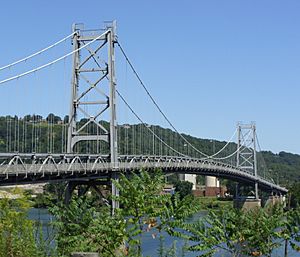Fort Steuben Bridge facts for kids
Quick facts for kids Fort Steuben Bridge |
|
|---|---|
 |
|
| Coordinates | 40°22′47″N 80°36′48″W / 40.37982°N 80.61329°W |
| Carries | 2 lanes of vehicular traffic, 1 pedestrian sidewalk |
| Crosses | Ohio River |
| Locale | Between Steubenville, Ohio, and Weirton, West Virginia |
| Owner | Ohio Department of Transportation (ODOT) |
| Characteristics | |
| Design | Suspension bridge |
| Material | Steel superstructure |
| Total length | 1,584 ft 9 in (483.03 m) |
| Width | 29 ft 3 in (8.92 m) |
| Longest span | 688 ft 9 in (209.93 m) |
| Number of spans | 7 |
| Piers in water | 6 |
| Clearance below | 41.3 ft (12.6 m) above high water |
| History | |
| Engineering design by | The Dravo Contracting Company |
| Construction end | 1928 |
| Closed | January 2009 (closed) February 21, 2012 (demolished) |
The Fort Steuben Bridge was a suspension bridge that crossed the Ohio River. It connected Steubenville, Ohio and Weirton, West Virginia. The bridge was first called the Weirton-Steubenville Bridge.
It opened in 1928 and was a toll bridge at first. The bridge helped traffic, especially trucks, cross the river more directly. It carried U.S. Route 22 and later Ohio State Route 822. In 2006, the bridge had weight limits put on it. It closed in 2009 because it was getting old and weak. The Fort Steuben Bridge was taken down on February 21, 2012.
Contents
Building the Bridge
The construction of the bridge started in 1927. It was finished just one year later, in 1928. The company in charge of building it was the Dravo Contracting Company.
They called the project the "Stanton Bridge over the Ohio River at Steubenville, Ohio." The bridge was very long, measuring about 1,584 ft 9 in (483.03 m). It was also 29 ft 3 in (8.92 m) wide.
The Bridge's Working Life
The Fort Steuben Bridge opened in November 1928. It was an important link between Steubenville, Ohio and Weirton, West Virginia. At first, people had to pay a toll to cross it.
The bridge was the main way for U.S. Route 22 to cross the Ohio River. Many trucks and heavy vehicles used it. These vehicles were often from the factories and businesses in the Weirton-Steubenville area. The Fort Steuben Bridge made travel much easier. Before it, traffic had to use the Market Street Bridge.
Tolls and Ownership
In 1940, it cost 5 cents for people walking across. Cars had to pay 25 cents. The toll was removed in 1947. This happened when the State of Ohio took over owning the bridge. Some improvements were made to the bridge in 1956.
Traffic Problems
By the late 1970s, too many cars were using the bridge. This caused a lot of traffic jams. A study in 1978 showed that the bridge could handle 1,600 vehicles per hour. But sometimes, traffic got close to its maximum of 1,920 vehicles per hour. This could cause the bridge to get completely stuck.
Because of these problems, leaders decided the bridge needed to be replaced. The United States Senate said replacing it was a top priority in 1983.
Replacing the Bridge
The new bridge, called the Veterans Memorial Bridge, was finished in 1990. This new bridge took over much of the traffic.
After the new bridge opened, the Ohio Department of Transportation limited how much money they would spend on the Fort Steuben Bridge. In 2006, the Fort Steuben Bridge became weaker. Because of this, heavy trucks were no longer allowed to use it. The bridge was also known to shake when it rained.
Closing and Taking Down the Bridge
On January 8, 2009, workers noticed a dip in the bridge's surface. This led to a full inspection. On January 15, 2009, the Ohio Department of Transportation decided the bridge was unsafe. They said the bridge's floor was getting much worse.
Repairs were not done because the bridge was already planned to be taken down later that year. Fixing it would have cost too much money for something that was going to be demolished soon.
Demolition Day
The Fort Steuben Bridge was destroyed in a controlled demolition on February 21, 2012. A company named Joseph B. Fay Co. was hired to do the job. First, they removed the road and the parts leading up to the bridge.
They used 490 special explosives called linear shape charges. These were placed in 136 spots along the bridge. The total amount of explosives was 153 pounds (69 kg). The charges went off in 20 quick blasts. Each blast lasted only 0.35 seconds, happening just milliseconds apart. After the bridge fell, another company cleaned up all the pieces. The demolition was even shown in a magazine called Scholastic SuperScience!

